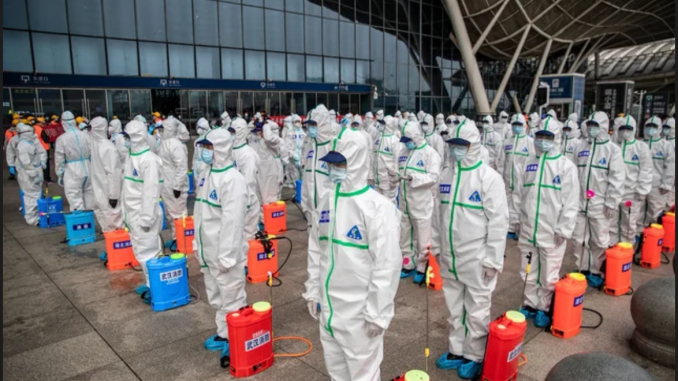
For more than two years we have lived through a pandemic that no one — no one who doesn’t fall for Communist Chinese propaganda anyway — doubts came from China.
In fact, the consensus now is that COVID came from the Wuhan lab, something I wrote about in these pages at the outset of the outbreak. In recent months, many of those who had earlier parroted Beijing’s line about COVID coming from a bat cave, including China’s man at the World Health Organization, Dr. Tedros Ghebreyesus, have come over to my point of view.
At the same time, there is mounting evidence that the coronavirus was developed as part of China’s bioweapons program.
But, leaving all this aside, there is no doubt on one key point. The Chinese Communist Party has a long history of covering up epidemics within China, and then carelessly — or deliberately — allowing them to spread around the world.
The fall of 1957 saw an outbreak of what came to be known as the Asian flu. It was first reported in the cities of Singapore and Hong Kong, but this new and deadly influenza soon went global.
China played no role in its creation — in this case the offending virus truly did have a natural origin — but it certainly did play a role in its spread. The new flu had arisen in the interior province of Guizhou in early 1957, and had spread throughout China in the months following. But even as tens of thousands of Chinese lay dying, the epidemic was kept hidden from view by the Communist authorities.
When infected travelers from China later carried it to Hong Kong and Singapore, the World Health Organization and other public health authorities were caught flatfooted. Thanks to Beijing’s perfidy, quarantines and vaccines came too late. Before the Asian flu had run its two-year course, it had killed well over a million people.
A girl drinks broth in a Japanese hospital during the 1957 Asian flu outbreak, which first emerged in China and later spread throughout Asia. Like with COVID, Chinese officials were accused of covering up its earliest cases.
The same scenario played out again 10 years later. In 1968, an unknown influenza had quickly spread throughout the world. It came to be known as the Hong Kong flu, infuriating that city’s Chamber of Commerce, the members of which knew quite well that an epidemic was raging in Mainland China just across the border. Once again, the Communist authorities had refused to alert the world, and another million people died.
China continued to play “hide the virus” when the SARS epidemic broke out in 2002. Patient Zero was a snake seller in China’s Guangdong province who came down with the disease on Nov. 16, 2002. He died shortly thereafter, and hundreds of other cases were soon recorded by Chinese health officials.
But the Communist regime lied about the disease for months, silenced whistleblowers, doctored data, duped global health authorities, and even accused “outside forces” of carrying out a “bioterrorist” attack.
Sound familiar?
They did not inform the WHO about the outbreak until February 2003, three months later, and only after Canadian intelligence had already detected and publicly reported on a “flu outbreak” in progress in China.
SARS — short for “severe acute respiratory syndrome” — was a viral respiratory illness caused by a coronavirus. It had the highest case fatality rate of any influenza since the Spanish flu. Eleven percent of those who came down with SARS died.
Like the Spanish flu, SARS could easily have killed tens of millions worldwide had the Canadians not forced Beijing to reveal its existence before it had spread outside of its borders. Its containment was aided by the fact that, while it was highly infectious, it was not airborne. As a result of its early detection and relatively low transmissibility, by the time the SARS epidemic ended in June of 2003, there had been a total of only 8,469 cases reported.
But the lethality of SARS impressed China’s bioweapons experts, and they began discussing how to genetically engineer a SARS-like coronavirus that could easily be transmitted from person to person. The kind where a single sneeze can infect an entire roomful of people.
In late 2017, a Chinese researcher named Dr. Shi Zhengli, with the help of British zoologist Peter Daszak of EcoHealth Alliance, a beneficiary of US government funding and an ally of Dr. Anthony Fauci, traced the original SARS virus back through an intermediary host to the original carriers: the cave-dwelling horseshoe bats of Yunnan province.
Somewhere in China, perhaps even at the Wuhan Institute of Virology itself, they are even now genetically engineering new “unrestricted bioweapons.” Anyone who thinks China’s biotechnology labs are going to be used for noble scientific purposes is committing the same fatal error that Dr. Fauci did.
Another plague — again from China — is almost certain to hit us in our lifetimes. Indeed, the very bioweapon that will be used may already be lurking in a test tube somewhere.
Steven W. Mosher is the President of the Population Research Institute. This piece was adapted from his new book, “The Politically Incorrect Guide to Pandemics” (Regnery), published on July 26.
* Article from: The New York Post


